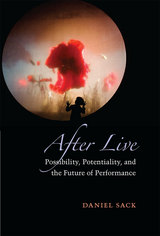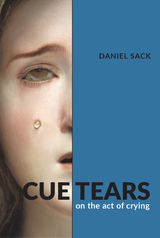2 books about Sack, Daniel

After Live
Possibility, Potentiality, and the Future of Performance
Daniel Sack
University of Michigan Press, 2015
In the dark of the blackout before the curtain rises, the theater holds its many worlds suspended on the verge of appearance. How can a performance sustain this sense of potentiality that grounds all live production? Or if a stage-world does begin, what kinds of future might appear within its frame? Conceiving of the theater as a cultural institution devoted to experimenting with the future, this book begins and ends on the dramatic stage; in between it traverses literature, dance, sculpture, and performance art to explore the various futures we make in a live event.
After Live conceives of traditional dramatic theater as a place for taming the future and then conceptualizes how performance beyond this paradigm might stage the unruly nature of futurity. Chapters offer insights into the plays of Beckett, Churchill, Eno, and Gombrowicz, devised theater practices, and include an extended exploration of the Italian director Romeo Castellucci. Through the lens of potentiality, other chapters present novel approaches to minimalist sculpture and dance, then reflect on how the beholder him or herself is called upon to perform when confronted by such work.
[more]

Cue Tears
On the Act of Crying
Daniel Sack
University of Michigan Press, 2024
Crying holds a privileged place in conversations around emotions as an expression of authentic feeling. And yet, tears are ambiguous: they might signal the most positive and negative of affects; they might present a sincere revelation of self or be simulated to manipulate others. Unsurprisingly, tears figure prominently on stage and on screen, where actors have experimented with the mechanics of making tears. Cue Tears: On the Act of Crying uses tears as a prism through which to see some of the foundational problems and paradoxes of acting and spectatorship anew, including matters of authenticity and sincerity, the ethics of the witness, the interaction between a speech act and its affective force, liveness and documentation.
Across seven semi-autonomous essays, Cue Tears looks at the mechanisms of tear production, internal and external techniques that actors use to weep, and the effects of tears in performance situations on the stage, in the gallery, and in the classroom. The writing moves with a light touch between theory and criticism of a broad range of instances from literature, theater, performance art, visual art, and cinema, while also embracing a strong autobiographical and personal slant. Author Daniel Sack’s father was a biochemist who studied tears and collected his son’s tears for research during his childhood. These “reflex tears” were produced as a physical response to irritation—an eye stretched past the point of blinking, a cotton swab up the nose. This childhood occupation coincided with his first years taking acting classes, trying to learn how to cry “emotional tears” onstage through psychological stimulation and the recollection of memory. Cue Tears investigates these memories and methods, finding that tears both shore up and dissolve distinctions between truth and artifice, emotional and physical, private and public, sad and humorous.
Across seven semi-autonomous essays, Cue Tears looks at the mechanisms of tear production, internal and external techniques that actors use to weep, and the effects of tears in performance situations on the stage, in the gallery, and in the classroom. The writing moves with a light touch between theory and criticism of a broad range of instances from literature, theater, performance art, visual art, and cinema, while also embracing a strong autobiographical and personal slant. Author Daniel Sack’s father was a biochemist who studied tears and collected his son’s tears for research during his childhood. These “reflex tears” were produced as a physical response to irritation—an eye stretched past the point of blinking, a cotton swab up the nose. This childhood occupation coincided with his first years taking acting classes, trying to learn how to cry “emotional tears” onstage through psychological stimulation and the recollection of memory. Cue Tears investigates these memories and methods, finding that tears both shore up and dissolve distinctions between truth and artifice, emotional and physical, private and public, sad and humorous.
[more]
READERS
Browse our collection.
PUBLISHERS
See BiblioVault's publisher services.
STUDENT SERVICES
Files for college accessibility offices.
UChicago Accessibility Resources
home | accessibility | search | about | contact us
BiblioVault ® 2001 - 2024
The University of Chicago Press









